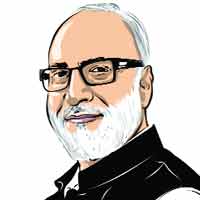Opinion Ashok Gulati writes on the US and India: Old friends in a changing world
It’s time that the deepening relations between the two expand to take on the challenges of climate change and food security
 PM Modi's emphasis that growth has to be pro-people and pro-planet is clear and commendable, and so is his appeal to include the African Union in the G-20 grouping. (Illustration by C R Sasikumar)
PM Modi's emphasis that growth has to be pro-people and pro-planet is clear and commendable, and so is his appeal to include the African Union in the G-20 grouping. (Illustration by C R Sasikumar) Watching Prime Minister Narendra Modi addressing the US Congress a second time, and talking to the Indian diaspora, one thing is very clear: US-India relations are deepening and widening. And if one goes by PM Modi’s speech to the Congress, this is a momentous development that will benefit not just the US and India, but the world at large. The cooperation in defence, space and high-tech chip-making may just be the beginning. The potential in many other sectors is enormous. Modi’s pitch for inclusive and sustainable growth has to be seen in that context. His emphasis that growth has to be pro-people and pro-planet is clear and commendable, and so is his appeal to include the African Union in the G-20 grouping.
But one may be curious to know what has brought the US and India so close at this juncture. Is it the increasing market size of the Indian economy? Or is it the growing influence of the Indian diaspora in American business and politics? Or is it the need of the hour to contain Chinese aggression?
The short answer may be that it is a mix of all these three factors. But my discussions with the Indian diaspora living in the US for decades suggest that the China factor may be the most important one for the current bonhomie. China’s meteoric rise on the economic front over the last four and half decades, with accompanying military power, is being seen as a threat to global security by many nations.
 Join us for the next edition of Explained.Live
Join us for the next edition of Explained.Live
Hence the need to contain its aggressive designs. The QUAD comprising Australia, Japan, India, and the US is one such forum for the process. The current US-India friendship is only an extension of that at a bilateral level. This makes one thing clear: As nations become rich, they need to be responsible towards global peace and welfare. Else, they will invite counter-balancing by many other countries, which may not be good for world peace and prosperity.
There is no doubt that the US has been a superpower both in economic terms as well as in its military might for quite some time. As per the International Monetary Fund (IMF), the US economy in April 2023 stood at $26.6 trillion with a per capita GDP of $80,000 at current prices. In comparison to that, India is way behind with an overall GDP of $3.74 trillion and a per capita GDP of just $2,600. India’s per capita income is in fact the lowest among G-20 countries. In PPP terms, however, India’s GDP improved to $13 trillion and its per capita GDP to about $9,000.
Thus, the dollar-to-PPP conversion factor is roughly 3.5, which in simple terms means that a dollar in India can buy roughly 3.5 times more goods and services than in the US. Thus, the difference between the US and Indian economies and the welfare of their people narrows when we look at these indicators in PPP terms rather than current US dollars. Interestingly, China, in PPP terms, is already the largest economy ($33 trillion) with a per capita GDP in PPP terms of about $23,380. In current US dollar terms, of course, the Chinese economy stands at $19.37 trillion, next only to the US. And, China’s per capita GDP in current US dollars terms is only $13,720, which gives the dollar-to-PPP conversion factor just 1.7 as against India’s conversion factor of 3.5.
For world peace and prosperity, it would be best if the three countries can work together. But the foundation of any friendship and working together is trust, which requires transparency in behaviour and actions as per the agreed rules of the game. And it is here that the political system of democracy wins over authoritarian regimes. Not that democracy is without its flaws, be it in the US or India, but it is certainly better than military or authoritarian regimes. And now with the Ukraine-Russia conflict, global powers are realigning into new groupings. India has a tough task of walking a very tightrope between Russia and the US. One can only hope that Prime Minister Modi can calibrate this balancing act and bring dialogue and diplomacy to resolve strong differences, and not be part of the ever-widening chasm which can be suicidal to the existence of humanity on this planet.
There is no doubt that border security is paramount to India, as it is to Ukraine or any other country. But for the eight billion people on this planet, food and nutritional security is of equal importance, if not more. This is being threatened by climate change with increasing temperatures. The poorer nations suffer disproportionately more. India is no exception, given its large population of 1.4 billion. The US is at the forefront of technologies not just in defence, space, and semiconductors but also in agriculture. One may recall that in the 1960s when India was struggling to feed its fast-growing population, several state agricultural universities were opened with the support and mentoring of their counterparts in the US. These universities were instrumental in shaping India’s Green Revolution, although the initial seeds of high-yielding varieties of wheat and rice came from outside.
Today, many of these universities are unable to check the damage to land, water and air that the current practices of agriculture are leading to. Punjab is a classic example where the water table has been depleting at an alarming rate. The time has come to rejuvenate our agricultural universities with cutting-edge technologies and policies to cope with climate change and produce more nutritious food with less land, less water, and less GHG emissions. I hope in the next round of US-India collaboration, there will be a special attempt to include food and agriculture as one of the core areas of cooperation. It has the potential to do good to the maximum number of people in the developing world, be it in Asia or Africa.
Gulati is Distinguished Professor at ICRIER. Views are personal






